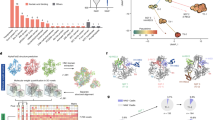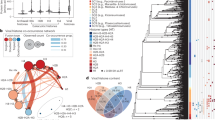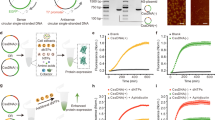Abstract
We describe the development of the baculovirus Autographa californica nuclear polyhedrosis virus (AcNPV) as a vector for the display of distinct proteins on the viral surface in a manner that is analogous to the established bacterial “phage display” systems. As a model system, the marker gene encoding the 26kDa protein glutathione-S-transferase (GST) was used to construct several fusions with the major baculovirus glycoprotein gp64 gene. Following expression in Spodoptera frugiperda (Sf9) cells, the yield and cellular distribution of each GST-gp64 protein was assessed by Western blot of both cell and supernatant fractions. One fusion, in which GST was inserted between the leader peptide and the mature protein, was found to be efficiently secreted into the cell medium. In the context of expression of the foil length gp64, the hybrid GST-gp64 was shown by immunogold labelling to be incorporated onto the virion surface. In addition, the affinity purification of the soluble transmembrane gp64-GST fusion protein resulted in the co-purification of wild type gp64 suggesting that co-oligomerization of the GST-tagged fusion and the wild type molecule was the basis for virion incorporation. The HIV major surface glycoprotein, gpl20, was also efficiently displayed in functional form on the viral surface following fusion to the amino terminus of gp64. A general expression vector, pAcSurf-2, was constructed in which multiple cloning sites were positioned in-phase between the gp64 signal sequence and the sequence encoding the mature protein under the control of the polyhedrin promoter.
This is a preview of subscription content, access via your institution
Access options
Subscribe to this journal
Receive 12 print issues and online access
$209.00 per year
only $17.42 per issue
Buy this article
- Purchase on Springer Link
- Instant access to full article PDF
Prices may be subject to local taxes which are calculated during checkout
Similar content being viewed by others
References
Phizicky, E.M. and Fields, S. 1995. Protein-protein interactions: Methods for detection and analysis. J. Virol. 59: 94–123.
McCafferty, J., Griffiths, A.D., Winter, G. and Chiswell, D.J. 1990. Phage antibodies: filamentous phage displaying antibody variable domains. Nature 348: 552–554.
Winter, G., Griffiths, A.D., Hawkins, R.E. and Hoogenboom, H.R. 1994. Making antibodies by phage display technology. Annu. Rev. Immunol. 12: 433–435.
Fielder, K. and Simons, K. 1995. The role of N-glycans in the secretory pathway. Cell 81: 309–312.
Morikawa, Y., Moore, J.P. and Jones, I.M. HIV-1 envelope glycoprotein gp120 expression in E.coli: assessment of CD4 binding and use in epitope mapping. Journal of Virological Methods 29: 105–114.
Okayama, H. and Berg, P. 1983. A cDNA cloning vector that permits expression of cDNA inserts in mammalian cells. Mol. Cell. Biol. 3: 280–289.
Smith, G.E., Summers, M.D. and Frazer, M.J. 1983. Production of human beta-interferon in insect cells infected with a baculovirus expression vector. Mol. Cell. Biol. 3: 2156–2165.
Blissard, G.W. and Wenz, J.R. 1992. Baculovirus gp64 envelope glycoprotein is sufficient to mediate pH-dependent membrane fusion. J. Virol. 66: 6829–6835.
Whitford, M., Stewart, S., Kuzio, J. and Faulkner, P. 1989. Identification and sequence analysis of a gene encoding gp67, an abundant envelope glycoprotein of the baculovirus Autographa californica nuclear polyhedrosis virus. J. Virol. 63: 1393–1399.
Volkman, L.E. and Goldsmith, P.A. 1984. Budded Autographa californica NPV 64K protein: further biochemical analysis and effects of postimmuno-precipitation sample preparation conditions. Virology 139: 295–302.
Roberts, S.R. and Manning, J.S. 1993. The major envelope glycoprotein of the extracellular virion of Autographa californica nuclear polyhedrosis virus possess at least three distinct neutralising epitopes. Virus. Res. 28: 285–297.
Ayres, M.D., Howard, S.C., Kuzio, J., Lopez-Ferber, M. and Possee, R.D. 1994. The complete DNA sequence of Autographa californica nuclear polyhedrosis virus. Virology 202: 586–605.
O'Reilly, D.R., Miller, L.K. and Luckow, V.A. 1992. Baculovirus expression vectors: a laboratory manual, 1st ed. W.H. Freeman and Company, New York.
Livingstone, C. and Jones, I.M. 1989. Baculovirus expression vectors with single-strand capability. Nucl. Acids Res. 17: 2366.
Monsma, S.A. and Blissard, G.W. 1995. Identification of a membrane fusion domain and an oligomerisation domain in the baculovirus gp64 envelope fusion protein. J. Virol. 69: 2583–2595.
Harris, M.P.G. and Coates, K. 1993. Identification of cellular proteins that bind to the human immunodeficiency virus nef protein in vitro: a role for myristoylation. J.Gen. Virol. 74: 1581–1589.
Smith, D.B. and Johnson, K.S. 1988. Single-step purification of polypeptides expressed in Eschericia coli as fusions with glutathione-S-transferase. Gene. 67: 31–40.
Wang, Y.H., Davies, A.H. and Jones, I.M. 1995. Expression and purification of of glutathione-S-transferase tagged HIV-1 gp120; no evidence for an interaction with CD26. Virology 208: 142–146.
Kitts, P., Ayres, M. and Possee, R. 1991. Linearisation of baculovirus DNA improves the selection of recombinant transfer vectors. Nucl. Acids Res. 18: 5667–5672.
Jarvis, D.L. and Garcia, A. Jr. 1994. Biosynthesis and processing of the Autographa californica nuclear polyhedrosis virus gp64 protein. Virology 205: 300–313.
Leonard, C.K., Spellman, M.W., Riddle, L., Harris, R.J., Thomas, J.N. and Gregory, T.J. 1990. Assignment of intrachain disulfide bonds and characterization of potential glycosylation sites of the type 1 recombinant human immunodeficiency virus envelope glycoprotein (gp120) expressed in Chinese hamster ovary cells. J. Biol. Chem. 265: 10373–10382.
Fenouillet, E., Gluckman, J.-C. and Jones, I.M. 1994. Functions of HIV envelope glycans. T. I. B. S. 19: 65–70.
Davies, A.H. 1994. Current methods for manipulating baculoviruses. Bio/Technology. 12: 47–50.
Peakman, T.C., Charles, I.G., Sydenham, M.A., Gewert, D.R., Page, M.J. and Makoff, A.J. 1992. Enhanced expression of recombinant proteins in insect cells using a baculovirus vector containing a bacterial leader sequence. Nucl. Acids Res. 20: 6111–6112.
Burke, K.L., Dunn, G., Ferguson, M., Minor, P.D. and Almond, J.W. 1988. Antigen chimaeras of poliovirus as potential new vaccines. Nature 332: 81–82.
Turpen, T.H., Reinl, S.J., Charoenvit, Y., Hoffman, S.L., Fallarme, V. and Grill, L.K. 1995. Malarial epitopes expressed on the surface of recombinant tobacco mosiac virus. Bio/Technology. 13: 53–57.
Usha, R., Rohll, J.B., Spall, V.E., Shanks, M., Maule, A.J., Johnson, J.E. and Lomonossoff, G.P. 1993. Expression of an animal virus antigenic site on the surface of a plant virus particle. Virology 197: 366–374.
Morris, T.D. and Miller, L.K. 1993. Characterisation of productive and nonproductive AcMNPV infection in selected cell lines. Virology 197: 339–348.
Overton, H.A., Fujii, Y., Price, I.R. and Jones, I.M. 1989. The protease and gag gene products of the human immunodeficiency virus: authentic cleavage and post-translational modification in an insect cell expression system. Virology 170: 107–116.
Sambrook, J., Fritsch, E.F. and Maniatis, T. (Eds.) 1989. Molecular Cloning: A Laboratory Manual. Cold Spring Harbor Laboratory Press, New York.
Hohmann, A.W. and Faulkner, P. 1983. Monoclonal antibodies to baculovirus strcutural proteins: determination of specificities by Western blot analysis. Virology 125: 432–444.
Keddie, B.A., Aponte, G.W. and Volkman, L.E. 1989. The pathway of infection of Autographa californica nuclear polyhedrosis virus in an insect host. Science 243: 1728–1730.
Moore, J.P. 1990. Simple methods for monitoring HIV-1 and HTV-2 gp120 binding to soluble CD4 by enzyme-linked immunosorbent assay: HIV-2 has a 25-fold lower affinity than HIV-1 for soluble CD4. AIDS 4: 297–305.
Author information
Authors and Affiliations
Corresponding author
Rights and permissions
About this article
Cite this article
Boublik, Y., Bonito, P. & Jones, I. Eukaryotic Virus Display: Engineering the Major Surface Glycoprotein of the Autographa californica Nuclear Polyhedrosis Virus (AcNPV) for the Presentation of Foreign Proteins on the Virus Surface. Nat Biotechnol 13, 1079–1084 (1995). https://doi.org/10.1038/nbt1095-1079
Received:
Accepted:
Issue Date:
DOI: https://doi.org/10.1038/nbt1095-1079
This article is cited by
-
Preincubation with a low concentration of methyl-β-cyclodextrin enhances baculovirus expression system productivity
Biotechnology Letters (2019)
-
Construction of a highly efficient display system for baculovirus and its application on multigene co-display
Molecular Genetics and Genomics (2018)
-
The localization of a heterologous displayed antigen in the baculovirus-budded virion determines the type and strength of induced adaptive immune response
Applied Microbiology and Biotechnology (2017)
-
Baculovirus display of functional antibody Fab fragments
Cytotechnology (2015)
-
Study on nanocomposite construction based on the multi-functional biotemplate self-assembled by the recombinant TMGMV coat protein for potential biomedical applications
Journal of Materials Science: Materials in Medicine (2015)



